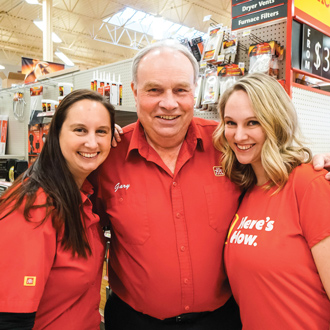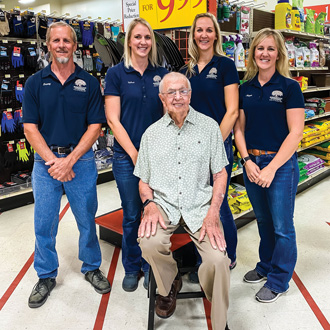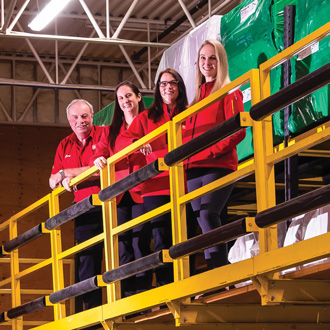The future of the independent home improvement industry in many ways depends on the next generation of retailers to take the reins over the course of the next decade. In a recent Hardware Retailing reader survey, nearly 75 percent of respondents were older than 46. Many retailers on the younger side of that spectrum could be in the middle of executing succession plans with their own families or already be in the beginning stages of developing their own plans with their children or employees.
In generations past in this industry, it was often the expectation that children of owners would take over the business. That viewpoint has waned over the last 30 years. Many retailers who were unexpectedly thrust into leadership roles in their family business when their parents died made a commitment to not put the next generation in the same predicament.
On the following pages, meet two industry families whose histories—and futures—mirror each other in remarkable ways. Learn how they have navigated the intricacies of family business for three generations and how they developed comprehensive plans to ensure the operations’ growth through the fourth generation and beyond.
Growing Up Retail
Gary Thulin, owner of Pioneer Home Hardware Building Centre in Campbell River, British Columbia, grew up in the business his grandparents opened in 1937. His story is similar to many retailers, starting in the business at age 12 doing odd jobs.

“It was a great way to learn the whole business,” Gary says. “It also allowed me to earn the respect of the other employees because my brothers and I were not just handed the business. We had to work our way up from the very bottom. I have carried this ideology through my entire 50 years in the business: No job is too good for the boss.”
Eventually, Gary’s parents took the business over from his grandparents, and then his older brother Glen got involved. Gary and Glen’s other brother Dean returned to help when their father became ill with cancer. Working alongside their father’s second-in-command, the brothers learned the ins and outs of the business quickly so they were prepared to take over when their father eventually died from his illness.
For Danny Baumstark, owner of Hermann Lumber Co. in Hermann, Missouri, and New Haven Lumber in New Haven, Missouri, he always knew he wanted to take over the business his grandfather Albert Baumstark started working for in the 1920s. Albert and his son Charles eventually bought out the business in the 1970s so it was completely owned by the Baumstark family.
“My brothers and I grew up working in the business the same way my dad did,” Danny says. “We did odd jobs and worked our way up. We all had choices about how we wanted to be involved as we grew up, and we figured out a good split of the responsibilities.”
Pioneer Home Hardware
Smoothing Transitions
Because Gary and his brothers had unexpectedly needed to take over after their father’s death, Gary says he knew early on he wanted to establish a more formal succession plan for the next generation. Across the three brothers who represented the third generation of ownership, there were now seven children in the fourth generation who could potentially join the business.
“It was an ongoing conversation as five of the seven children all worked in the store at various times,” Gary says. “I always insisted that the next generation had to prove themselves before they were allowed to join the business as an owner. We had some family dynamics between the brothers, and I wanted to make sure that did not happen to the next generation that took over the store.”

To get started on the formal plan for the next generation—Gary’s daughters Allison Kilby and Theresa Handel—Gary consulted his attorney and his accountant for guidance. The result was a share purchase agreement that Gary says helped negate the possibility of emotional decision-making and set up the company for all possible scenarios.
As the company saw significant growth, the next step was to get a share valuation and freeze the current shares into preferred shares and reissue new common shares. Gary set up his common shares into a trust that his daughters are each named in.
“Allison came to me about joining the company after she graduated university,” Gary says. “She showed the passion I had expected from a future owner, so she became part of the ownership with my brothers and me.”
Two years later, Glen and Dean retired from the business, and Gary and Allison bought them out. It was at that point that Theresa surprised them both by expressing interest in returning to the operation. Because the business arrangements had already been established, Theresa’s priority was proving she was a good fit.
Around the same time, another employee was starting her path to ownership. Amber Spring started at Pioneer Home Hardware when she was a teenager, eventually leaving for another job after college. She moved back and was hired for a new role in the office. She eventually worked her way up to replace a retiring employee and then expressed interest in accounting. Amber pursued an accounting degree part time while continuing to work for the company. Two years after completing the program, she joined in the ownership agreement with Allison and Theresa.
“It’s always a good thing to have someone with that type of knowledge on staff,” Gary says. “I was the financial guy, so for me moving out and trying to teach Allison and Theresa the retail side, it was good to have Amber on the accounting side.”
Pioneer Home Hardware: Through the Years
Pioneer Home Hardware: Through the Years
The business that would become Pioneer Home Hardware Building Centre is founded in Campbell River, British Columbia, by Carl Sr. and Margaret Thulin.
1952
Carl Thulin Jr. and his wife Florence join the operation. Their four sons eventually work in the business as young teenagers, with three of them continuing through adulthood.
1970s
Growing up in the family business led to an opportunity to gain ownership in it for the Thulin’s sons, Gary and Glen, who because part owners in the 1970s.
1980s
When Carl Jr. dies unexpectedly in the early 1980s, Gary and Glen took over operations. Their brother Dean joined the ownership team later in the decade.
2010s
Gary’s daughter Allison Kilby joins the ownership team, and Glen and Dean retire. Employee Amber Spring earns her accounting degree to manage the company’s financials.
2016-2018
Gary’s younger daughter Theresa Handel returns to the business, and she and Amber join the ownership team. Theresa had spent a decade as a nursing instructor before coming back.
Hermann Lumber Co.
Mitigating the Potential for Conflict
Danny eventually took over the retail side of Hermann Lumber Co. while his younger brother Denis took over the construction company that operated out of the New Haven location. Their youngest brother Don pursued a career outside the business.
When it comes to having a formal succession plan, Danny’s father and grandfather followed a verbal agreement that eventually led to his father buying the business. Danny and his brothers had a similar arrangement but was controlled by a buy-sell agreement.

“Being family, we wanted to be sure there wasn’t any conflict. My brothers and I initiated a buy-sell agreement, and we all agreed I would be the one who would control the business as far as stock ownership was concerned,” he says. “We determined the stock ownership percentages based on that agreement.”
Not having a formal succession plan worked well for Danny and his brothers, but he says he did want to pursue a more formal arrangement to pass on the business to the three of four of his daughters who are involved in the company.
“Megan was the first to come into the business, and I let her buy into stock at that point,” he says. “Once my next daughter expressed interest, I thought it would be a good idea to set up a plan.”
Danny consulted his attorney to come up with a big-picture goal for the business and considered how the next generation or two would fit in to accomplish it. It also instituted a formal ownership exit plan for Danny.
“The result was getting the family business under a solid plan for the next generations,” Danny says. “As long as things work out the way we think they will, my goal is to put the business into my daughters’ hands and by the time I’m 80, I’ll be out completely from an ownership perspective.”
Hermann Lumber Co: Through the Years
Hermann Lumber Co: Through the Years
Klenk Lumber office worker Albert Baumstark is offered a management position by the company’s new owners. At that time, Hermann Lumber Co. was chartered.
1970s
Over the course of many years, Albert was given opportunities to buy stock in the company. He and his son Charles bought the remaining stock in the 1970s, making them the sole owners.
1972
Danny Baumstark, Charles’s son, buys his first stock in the company at 18 years old. He and his brothers eventually develop a buy-sell agreement and distribute stocks among them accordingly.
2002
Megan Stiers, Danny’s oldest daughter, joins Hermann Lumber Co. after attending college on a volleyball scholarship. She earned a degree in business, intending to return to the company.
2005
Rachel Korman, the second oldest Baumstark daughter, joins the business after graduating from college with her degree in business.
2012
Chelsea Rohlfing, the youngest Baumstark daughter, returns to Hermann Lumber Co. after earning a degree in marketing and working in that field for several years after college.
45 Becoming a Decision-Maker
Theresa and Megan approached their family businesses with different visions. They both had been involved at various levels since they were young, which is usually standard operating procedure for children of small business owners.

For Theresa, the family business wasn’t in her sights. In fact, after high school, she earned a degree in nursing and worked as a nursing instructor for more than a decade before considering coming into the family business.
“In 2015, I discussed my hope to return to the store with my dad and my sister,” Theresa says. “They were looking at the succession plan very closely at the time, as my dad was planning to retire. They were discussing finding a business partner for my sister, and although I was living in a different province at the time, I mentioned my desire to fill that role.”
For Megan, leading the business was never in doubt. She attended college on a volleyball scholarship and graduated with a degree business with an emphasis in management, preparing her to come back to Hermann Lumber Co.
“I knew when I graduated high school that I wanted to have a career in the family business,” she says. “But I also knew I wanted to continue my education in business first. While a lot of what you learn in this industry is hands on, there is a lot you can gain from a four-year program.”
As the oldest Baumstark daughter, Megan was the first of the fourth generation to join the business, while two of her younger sisters have returned over the last 16 years.
“My next youngest sister Rachel also attended college on a volleyball scholarship and pursued a business degree with the goal of returning to the family business,” Megan says. “Our youngest sister Chelsea, who also played collegiate volleyball, studied marketing and advertising and had a career in that industry for about three years before coming back.”
There was a sales position available at the family’s second location, New Haven Lumber, and like any other employee, Chelsea interviewed to make sure she was a good fit before joining the team.
“She’s a very hard worker and very driven, so I knew she would be a great addition, but it was important to go through that process with her,” Megan says. “We’ve all had to prove ourselves over time. Nothing was given to us and nothing was guaranteed.”
While the transitions for both families have been without significant conflict, that doesn’t mean there haven’t been difficult conversations and learning curves.
“When I told my sister I wanted to come back to the business, I didn’t know yet in what capacity,” Theresa says. “She and I both have different strengths, and we’re very different people, but that plays well into our business. There were some intense conversations— we’re sisters. But the one good thing about family is you know everyone is trying to make the best for the business. There’s a trust there inherently.”
Theresa says she and her other managers are trying to learn everything they can from Gary before he officially retires because “you don’t know what you don’t know.”
“I had no idea how much my dad had in his head from over 50 years in the industry,” Theresa says. “I’m glad I still have him as a resource. Every time he goes on a vacation, we learn a little more about what we don’t know. There are sometimes hiccups, and we have the confidence to work through them.”
While making big-picture decisions in their fathers’ absences can be daunting, Theresa and Megan agree that it’s just part of the succession process.
“There are a lot of hard decisions that will need to be made, and I know that especially in the beginning, as I do now, I will think about what Dad would have done or said when making those decisions,” Megan says. “In the end, you have and trust your knowledge and instincts and realize you will make some mistakes, but you learn from them and move on.”
The buy-sell agreements both families have established also set up the fifth generations for an even smoother transition if they have a desire to take over. Megan says her oldest child has started asking questions after he spent the summer working at the business, and she’s prepared to continue to answer them in an age-appropriate way.
“He was asking questions about who owns the business, who makes the decisions and how it all works,” she says. “His curiosity has been ignited, so we will see what the future holds.”
 Hardware Retailing The Industry's Source for Insights and Information
Hardware Retailing The Industry's Source for Insights and Information









